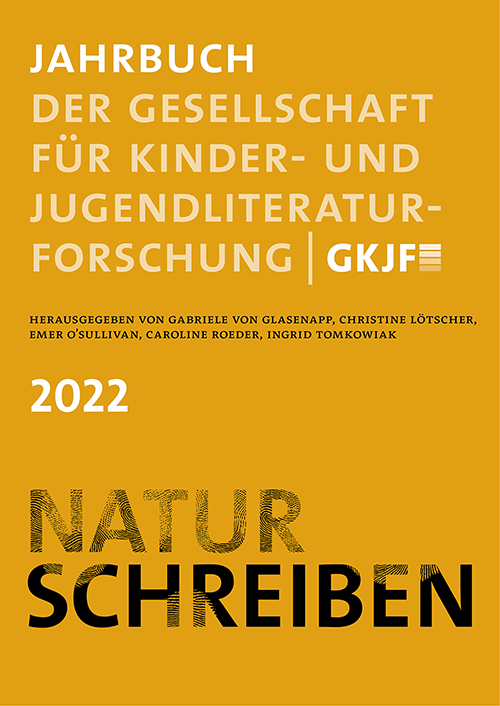Natur literarisch programmieren?
Virtuelle Umwelten in Ursula Poznanskis Roman Cryptos
DOI:
https://doi.org/10.21248/gkjf-jb.95Abstract
[English title and abstract below]
Die Jugendliteratur reagiert auf die zunehmenden Bedrohungen durch Klimawandel und Umweltkrisen schon seit Ende der Nullerjahre mit einer Art ,Future Nature Writing‘, das dystopische Zukunftswelten entwirft und Begegnungen mit intakter(er) Natur nur noch nostalgisch erinnert, fantastisch wiederherstellt oder medial simuliert. Letzteres ist innerhalb des jugendliterarischen Feldes ein relativ neues Phänomen, das im vorliegenden Beitrag am Beispiel des Romans Cryptos (Poznanski 2020) näher beleuchtet wird. Dabei wird auf Basis von Foucaults Raumtheorie zunächst hinterfragt, welche normativen Zuschreibungen und semantischen Codierungen mit den gegensätzlichen Räumen des Weltensystems verbunden werden und in welchen Machtkonstellationen die Figuren darin verortet sind. Daran anknüpfend rückt die Darstellung von virtueller Natur in den Fokus, wobei speziell die literarischen Verfahren von Interesse sind, die Immersion auf der einen und Reflexion auf der anderen Seite initiieren. Dieses zweischrittige Vorgehen zielt darauf ab, Spezifika literarischer Naturprogrammierung zu erarbeiten und Analysekategorien abzuleiten. Auf dieser Basis legt der Vergleich von Cryptos mit Hikikomori (Kuhn 2012) und Ready Player One (Cline 2017) Gemeinsamkeiten und Unterschiede in der literarischen Programmierung von Natur offen. Das Verhältnis von literarischem System und medialem Bezugssystem sowie die Wirkungsweisen von programmierter Natur in Literatur und Videospiel werden schließlich unter Bezugnahme auf Rajewskys Intermedialitätstheorie hinterfragt, sodass insgesamt verschiedene Facetten des Schreibens von virtueller Natur Berücksichtigung finden.
Programming Nature with Literature?
Virtual Environments in Ursula Poznanski’s Cryptos
Since the end of the first decade of the twenty-first century, young adult literature has reacted to the increased threats posed by climate change and environmental crises with a kind of ‘future nature writing’ that generates dystopian future worlds in which encounters with (more) intact nature are either nostalgically recalled, fantastically recreated or medially simulated. The latter is a relatively new phenomenon that this article will examine, taking Ursula Poznanski’s novel Cryptos (2020) as its main example. Based on Foucault’s theory of space, it first identifies the normative attributions and semantic codings associated with the opposing spaces of the world system and the power constellations in which the characters are located within the spaces. In a second step, the focus shifts to the representation of virtual nature, with the literary processes that initiate immersion on the one hand and reflection of a particular interest on the other. The aim of this two-step approach is to identify the specifics of literary nature programming and to develop categories for analysis. On the basis of this approach, a comparison between Cryptos, Hikikomori (2012) by Kevin Kuhn and Ready Player One (2017) by Ernest Cline exposes similarities and differences in the literary programming of nature. Finally, the relationship between the literary and the medial reference systems, as well as the mechanisms of programmed nature in literature and video games, is examined with reference to Rajewsky’s theory of intermediality so that different facets of writing virtual nature are taken into account.
Downloads
Veröffentlicht
Ausgabe
Rubrik
Lizenz
Copyright (c) 2022 Jahrbuch der Gesellschaft für Kinder- und Jugendliteraturforschung

Dieses Werk steht unter der Lizenz Creative Commons Namensnennung - Nicht-kommerziell 4.0 International.





